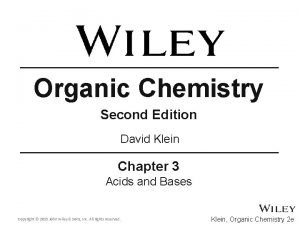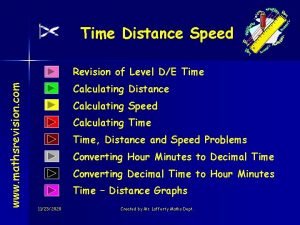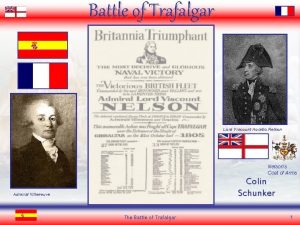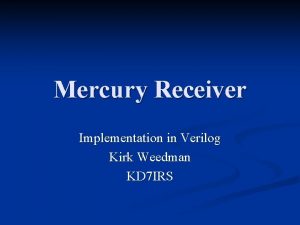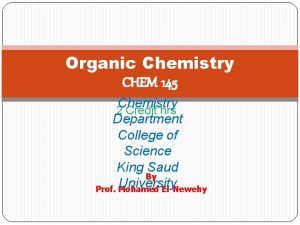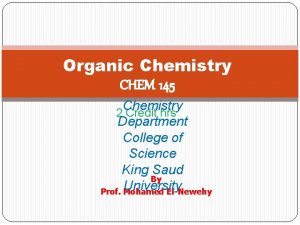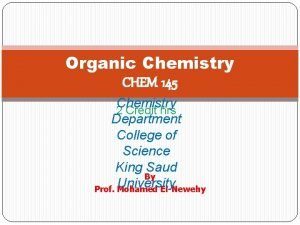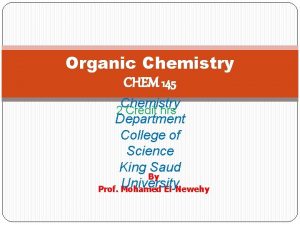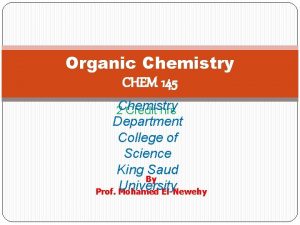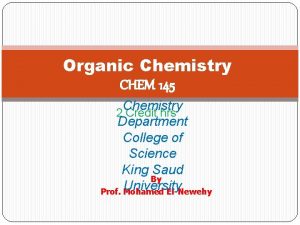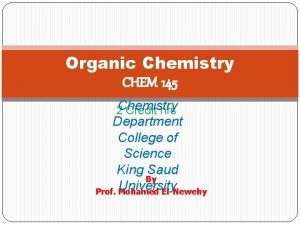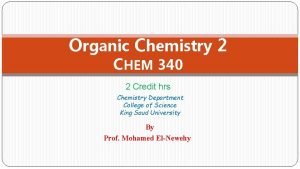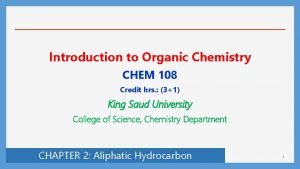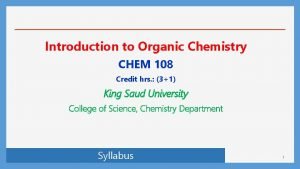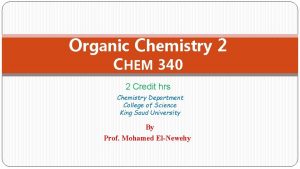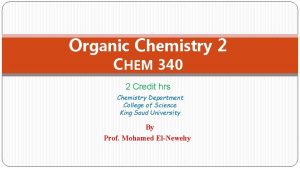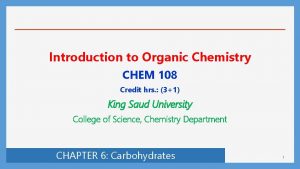Organic Chemistry CHEM 145 Chemistry 2 Credit hrs
















- Slides: 16

Organic Chemistry CHEM 145 Chemistry 2 Credit hrs Department College of Science King Saud By University Prof. Mohamed El-Newehy

Amines and other Nitrogen Compounds

Structure and Classification of Amines �Amines are compounds that derived from ammonia by replacement of one, two, or three hydrogens by alkyl or aryl groups. �Aliphatic amines contain only alkyl groups bonded directly to the nitrogen atom. �Aromatic amines are those in which one or more aryl groups are bonded directly to nitrogen.

� According to the number of R or Ar groups attached to the nitrogen atom, Amines are classified as; Primary (1°) Note Secondary (2°) Tertiary (3 ) �t-butyl alcohol is a tertiary alcohol (because three carbons are attached to the carbinol carbon), �t-butyl amine is a primary amine (because only one carbon is attached directly to the nitrogen atom).

Nomenclature of Amines Simple aliphatic amines are named by listing, in alphabetical � order, the alkyl groups attached to the nitrogen atom and adding the suffix –amine. Alkylamine �If two or three identical alkyl groups are attached to the nitrogen, the prefix di- or tri- is added to the name of the amine.

�If the amine is complicated, the IUPAC system is used. �In this system the amino group (—NH 2) is considered the Its position on the chain is indicated by the lowest possible �substituent, number. �The amino group is also considered a substituent if it is part of a molecule that contains another functional group. �Amine salts are named by replacing the suffix -amine by ammonium, followed by the name of the anion, which is written as a second word. Alkylammonium + name of anion

�Aromatic amines are usually named as derivatives of aniline. �The prefixes ortho (o-), meta (m-), and para (p-) are used to locate the position of a substituent. �If hydrocarbon groups are attached on the nitrogen atom, �The letter N is prefixed to the alkyl or aryl group name.

Physical Properties of Amines �Low-molecular-weight aliphatic amines (methyl-, dimethyl-, and trimethylamines) are �Colorless gases. in water. �Soluble �Amines containing 4 to 11 carbons atoms are liquids. Higher-molecular-weight amines are solids. � �Like ammonia, they form basic solutions. �They have characteristically unpleasant odors that resemble the odors of ammonia and dead fish. they possess a polar -N—H + bond, primary and secondary amines are capable of intermolecular hydrogen bonding. �Therefore their boiling points are �Because �Higher than those of alkanes of comparable molecular weight. Lower than those of alcohols of similar molecular � weight.

�Tertiary amines are also polar compounds, but because hydrogen is not bonded to nitrogen, these amines are incapable of intermolecular hydrogen bonding. �Therefore their boiling points are �Lower than primary and secondary amines of identical molecular weights. �Higher than those of alkanes of similar molecular weight. �All amines are capable of forming hydrogen bonds with water. �Amines with up to six carbons show appreciable solubility in water.

Basicity of Amines are bases because the nitrogen atom has a �Amines nonbonded pair of electrons. �This nonbonded electron pair can be donated to an acid’s proton to form an ammonium salt. �The more available the electron pair on N is to an acid, the stronger the base, and vice versa. �We can explain their greater basicity. Methyl groups are electron donors, they increase the electron density about the nitrogen atom to which they are attached, and therefore the non-bonded electron pairs are made more available for reaction with an acid

�Aliphatic amines. �For amines are more basic than aromatic example; The basicity of aniline turns out to be almost a million times weaker than that of methylamine. is attributed to resonance interactions. �The unshared pair of electrons in the resonance hybrid is not localized on the nitrogen atom in ammonia and aliphatic amines. �It is distributed over the aromatic ring, thus making it less available for sharing in reaction with a Lewis acid.

�Nitroaniline is even more weakly basic than aniline. because the electron-withdrawing effect of the –NO 2 group on � the ring. the electron density on the nitrogen atom, lowers � �making the electrons even less available for sharing with a Lewis acid Summary �Electron-releasing groups on the nitrogen atom of amines increase the basicity of amines, and electron-withdrawing groups decrease the basicity. Resonance effects in aromatic amines lower their � basicity. Electron-withdrawing � groups on the aromatic ring lower the basicity even more.

Preparation of Amines Reduction of Nitro Compounds, Nitriles and Amides; �Catalytic hydrogenation works well with nitro compounds and nitriles to give primary amines. �The carbonyl function of amides is reduced by lithium aluminum hydride, Li. Al. H 4.

�Aniline is prepared by reduction of nitrobenzene. The reducing agent most frequently used is tin and hydrochloric acid, Alkylation of Ammonia; �The non-bonded electron pair on the nitrogen makes ammonia an excellent nucleophile. �Ammonia is capable of attacking primary or secondary alkyl halides in an SN 2 reaction to give an alkylammonium salt. �Treatment of the alkylammonium salt with a strong base (Na. OH) liberates the free amine.

�The net result is the replacement of a hydrogen of ammonia by an alkyl group, the reaction is called alkylation of ammonia.

Conversion of Diazonium Salts �Aromatic diazonium salts are useful for preparing a host of substituted benzene derivatives.


